Islamic period
- Arab–Sasanian coinage
- THE SAFAVID PERIOD 1502-1722
- THE AFSHARID AND ZAND PERIOD 1722-94
- THE QAJAR PERIOD 1779-1925

Bahram IV, was the Sasanian King of Kings of Iran from 388 to 399. He was likely the son and successor of Shapur III.

Shapur III, was the Sasanian King of Kings of Iran from 383 to 388. He was the son of Shapur II and succeeded his uncle Ardashir II.
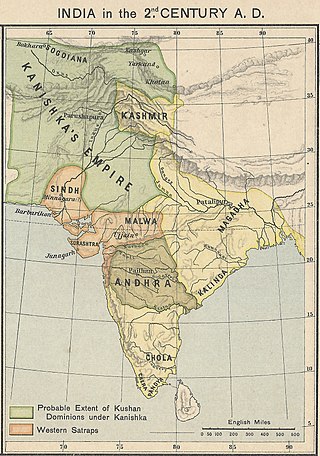
The Kushan Empire was a syncretic empire, formed by the Yuezhi, in the Bactrian territories in the early 1st century. It spread to encompass much of what is now Uzbekistan, Afghanistan, Pakistan and Northern India, at least as far as Saketa and Sarnath near Varanasi (Benares), where inscriptions have been found dating to the era of the Kushan Emperor Kanishka the Great.
The Kidarites, or Kidara Huns, were a dynasty that ruled Bactria and adjoining parts of Central Asia and South Asia in the 4th and 5th centuries. The Kidarites belonged to a complex of peoples known collectively in India as the Huna, and in Europe as the Chionites, and may even be considered as identical to the Chionites. The 5th century Byzantine historian Priscus called them Kidarite Huns, or "Huns who are Kidarites". The Huna/Xionite tribes are often linked, albeit controversially, to the Huns who invaded Eastern Europe during a similar period. They are entirely different from the Hephthalites, who replaced them about a century later.
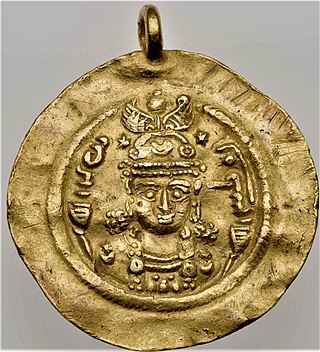
Boran was Sasanian queen of Iran from 630 to 632, with an interruption of some months. She was the daughter of king Khosrow II and the Byzantine princess Maria. She is the second of only three women to rule in Iranian history, the others being Musa of Parthia, and Boran's sister Azarmidokht.
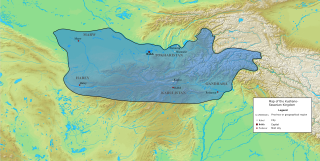
Kushano-Sasanian Kingdom is a historiographic term used by modern scholars to refer to a branch of the Sasanian Persians who established their rule in Bactria during the 3rd and 4th centuries CE at the expense of the declining Kushans. They captured the provinces of Sogdiana, Bactria and Gandhara from the Kushans in 225 CE. The Sasanians established governors for the Sasanian Empire, who minted their own coinage and took the title of Kushanshas, i.e. "Kings of the Kushans". They are sometimes considered as forming a "sub-kingdom" inside the Sasanian Empire. This administration continued until 360-370 CE, when the Kushano-Sasanians lost much of its domains to the invading Kidarite Huns, whilst the rest was incorporated into the imperial Sasanian Empire. Later, the Kidarites were in turn displaced by the Hephthalites. The Sasanians were able to re-establish some authority after they destroyed the Hephthalites with the help of the Turks in 565, but their rule collapsed under Arab attacks in the mid 7th century.
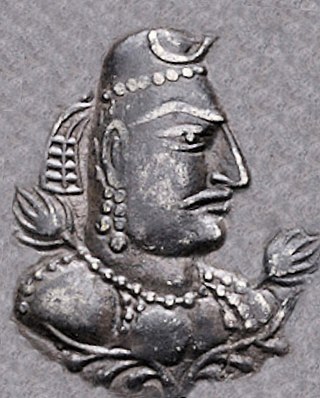
The Alchon Huns, also known as the Alchono, Alxon, Alkhon, Alkhan, Alakhana, and Walxon, were a nomadic people who established states in Central Asia and South Asia during the 4th and 6th centuries CE. They were first mentioned as being located in Paropamisus, and later expanded south-east, into the Punjab and Central India, as far as Eran and Kausambi. The Alchon invasion of the Indian subcontinent eradicated the Kidarite Huns who had preceded them by about a century, and contributed to the fall of the Gupta Empire, in a sense bringing an end to Classical India.

BahramKushanshah, was the last Kushanshah of the Kushano-Sasanian Kingdom from 330 to 365. He was the successor of Peroz II Kushanshah.

Frataraka is an ancient Persian title, interpreted variously as “leader, governor, forerunner”. It is an epithet or title of a series of rulers in Persis from 3rd to mid 2nd century BC, or alternatively between 295 and 220 BC, at the time of the Seleucid Empire, prior to the Parthian conquest of West Asia and Iran. Studies of frataraka coins are important to historians of this period.

The Kings of Persis, also known as the Darayanids, were a series of Persian kings, who ruled the region of Persis in southwestern Iran, from the 2nd century BCE to 224 CE. They ruled as sub-kings of the Parthian Empire, until they toppled them and established the Sasanian Empire. They effectively formed some Persian dynastic continuity between the Achaemenid Empire and the Sasanian Empire.
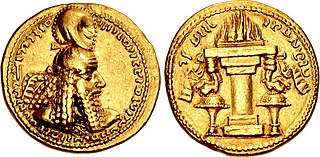
Sasanian coinage was produced within the domains of the Iranian Sasanian Empire (224–651). Together with the Roman Empire, the Sasanian Empire was the most important money-issuing polity in Late Antiquity. Sasanian coinage had a significant influence on coinage of other polities. Sasanian coins are a pivotal primary source for the study of the Sasanian period, and of major importance in history and art history in general. The Sylloge nummorum Sasanidarum is the most important primary work of reference for Sasanian coins.

The Sasanian coinage of Sindh refers to a series of Sasanian-style issues, minted from 325 to 480 CE in Sindh, in the southern part of modern Pakistan, with the coin type of successive Sasanian Empire rulers, from Shapur II to Peroz I. Together with the coinage of the Kushano-Sasanians, these coins are often described as "Indo-Sasanian". They form an important part of Sasanian coinage.
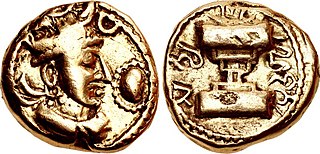
Rāṇāditya Satya, was a ruler in the area of Sindh, modern-day Pakistan, in the 5-6th centuries CE, probably circa 480 CE. The name "Rāṇāditya" is otherwise known, and it appears in several parts of the Rajatarangini.

Indo-Sasanian coinage was major type of coinage of the post-Gupta Empire period, in the areas of Gujarat and Rajasthan in western India and in the Gangetic region, from the 6th century to the 12th century CE. These coins were derived from the Sasanian coinage design, probably transmitted to the subcontinent by the Alchon Huns as they invaded northern India circa 500 CE. They are an important component of Indian coinage.

Parthian coinage was produced within the domains of the Parthian Empire. The coins struck by the Parthians were mainly made of silver, with the main currencies being the drachm and tetradrachm. The tetradrachm, which generally weighed around 16 g, was only minted in Seleucia, first conquered by the Parthians in 141 BC. Design-wise, Parthian coinage was based on Seleucid and Achaemenid satrapal coinage.
Hind was the name of a southeastern Sasanian province lying near the Indus River. The boundaries of the province are obscure. The Austrian historian and numismatist Nikolaus Schindel has suggested that the province may have corresponded to the Sindh region, where the Sasanians notably minted unique gold coins of themselves. According to the modern historian C. J. Brunner, the province possibly included—whenever jurisdiction was established—the areas of the Indus River, including the southern part of Punjab.

Stamp seal , is a historical stamp seal from the British Museum, with reference number BM 119999, located in Room 52 of the museum. The stamp seal was procured by Sir Alexander Cunningham, who sold it to the British Museum in 1870. Another, nearly identical, seal, is located in the Calcutta Museum.

Arab–Sasanian coinage is a modern term used to describe coins struck in the style of the coinage of the Iranian Sasanian Empire (224–651) after the Muslim conquest of Persia, on behalf of the Muslim governors of the early Islamic caliphates. These coins, mostly silver dirhams but also copper coins, were struck in the historic Sasanian lands of Iraq and Iran, and continued to show the portrait of a bust of a Sasanian emperor as well as other non-Islamic motifs of Sasanian coins, alongside Arabic inscriptions.

The Chilek silver bowl is a silver bowl found in the area of Samarkand, and considered as the "best known specimen of Hephthalite art". More specifically, the bowl seems to belong to the Alchon Huns, south of the Hindu-Kush, during the last third of the 5th century CE. The Alchons have long been considered as a part or a sub-division of the Hephthalites, or as their eastern branch, but now tend to be considered as a separate entity.